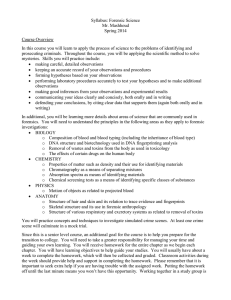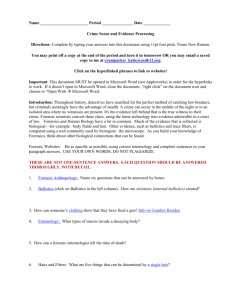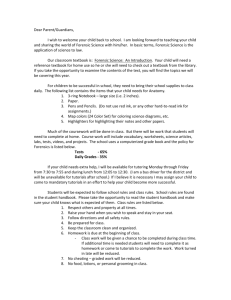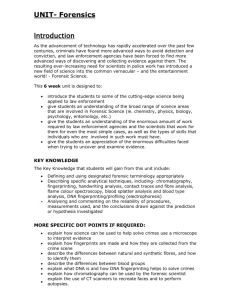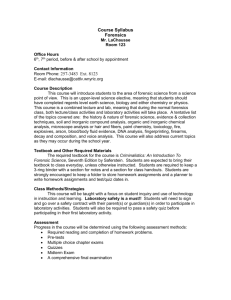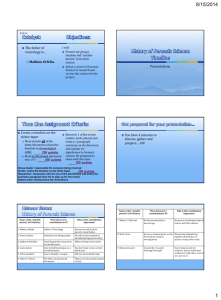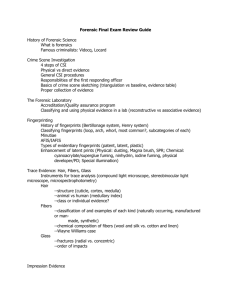Syllabus: Forensic Science
advertisement
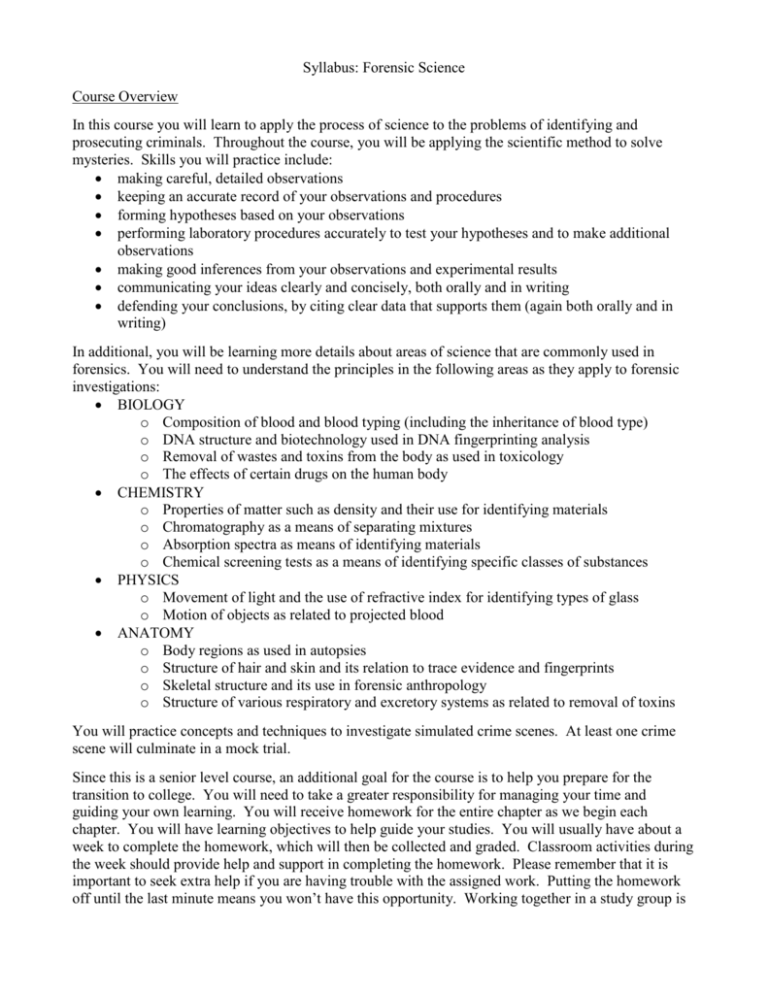
Syllabus: Forensic Science Course Overview In this course you will learn to apply the process of science to the problems of identifying and prosecuting criminals. Throughout the course, you will be applying the scientific method to solve mysteries. Skills you will practice include: making careful, detailed observations keeping an accurate record of your observations and procedures forming hypotheses based on your observations performing laboratory procedures accurately to test your hypotheses and to make additional observations making good inferences from your observations and experimental results communicating your ideas clearly and concisely, both orally and in writing defending your conclusions, by citing clear data that supports them (again both orally and in writing) In additional, you will be learning more details about areas of science that are commonly used in forensics. You will need to understand the principles in the following areas as they apply to forensic investigations: BIOLOGY o Composition of blood and blood typing (including the inheritance of blood type) o DNA structure and biotechnology used in DNA fingerprinting analysis o Removal of wastes and toxins from the body as used in toxicology o The effects of certain drugs on the human body CHEMISTRY o Properties of matter such as density and their use for identifying materials o Chromatography as a means of separating mixtures o Absorption spectra as means of identifying materials o Chemical screening tests as a means of identifying specific classes of substances PHYSICS o Movement of light and the use of refractive index for identifying types of glass o Motion of objects as related to projected blood ANATOMY o Body regions as used in autopsies o Structure of hair and skin and its relation to trace evidence and fingerprints o Skeletal structure and its use in forensic anthropology o Structure of various respiratory and excretory systems as related to removal of toxins You will practice concepts and techniques to investigate simulated crime scenes. At least one crime scene will culminate in a mock trial. Since this is a senior level course, an additional goal for the course is to help you prepare for the transition to college. You will need to take a greater responsibility for managing your time and guiding your own learning. You will receive homework for the entire chapter as we begin each chapter. You will have learning objectives to help guide your studies. You will usually have about a week to complete the homework, which will then be collected and graded. Classroom activities during the week should provide help and support in completing the homework. Please remember that it is important to seek extra help if you are having trouble with the assigned work. Putting the homework off until the last minute means you won’t have this opportunity. Working together in a study group is a very good way to learn the material. Please refer to the honor code for the ground rules that will allow you to work together productively without cheating. Course Details Text for the course will be Forensic Science: An Introduction by Richard Saferstein. The course will include the following chapters and topics: Chapter Topics and Skills Included Scope of forensics History of forensics Services offered by crime labs Making and recording observations (including sketches with measurements and digital photographs) Making inferences and citing evidence to support them Methods of obtaining and storing evidence Body areas and locating terms Autopsy procedures Recognizing types of physical evidence Collecting and storing physical evidence Keeping careful records Forensic Anthropology Mini-unit Names of major human bones Identifying skeletal remains and forensic anthropology 4 – Properties of Matter & the Analysis of Glass Physical properties of matter Properties of light Density Refractive Index Forensic analysis of glass, including ballistics Analyzing experimental results and drawing conclusions 5 - Drugs Commonly used drugs and their effects on the human body Chemical tests, chromatography, & spectrophotometry Alcohol & it relationship to human anatomy & metabolism Testing for drugs and poisons using pH. TLC, immunoassay, & chemical tests Types of laws Types of crimes Court proceedings ABO blood types & their inheritance Testing for blood using gel diffusion, Kastle-Meyer, & luminal Analysis of blood stain patterns Testing for other bodily fluids Review of DNA structure DNA analysis using PCR, restriction enzymes, RFLP analysis, and STR analysis Use of mDNA Review of microscope use and care (see Chapter 7) Structure of human skin and hair 1 - Introduction 2 – The Crime Scene 3 – Physical Evidence 6 – Forensic Toxicology Forensics and the Law (Preparing for Mock Trial) 8 – Forensic Serology 9 – DNA: The Indispensable Forensic Science Tool 10 – Trace Evidence I: Hairs and Fibers 14 - Fingerprints Microscopic analysis of hair and fibers Detection & analysis of fingerprints Additional topics will be added as time permits.
